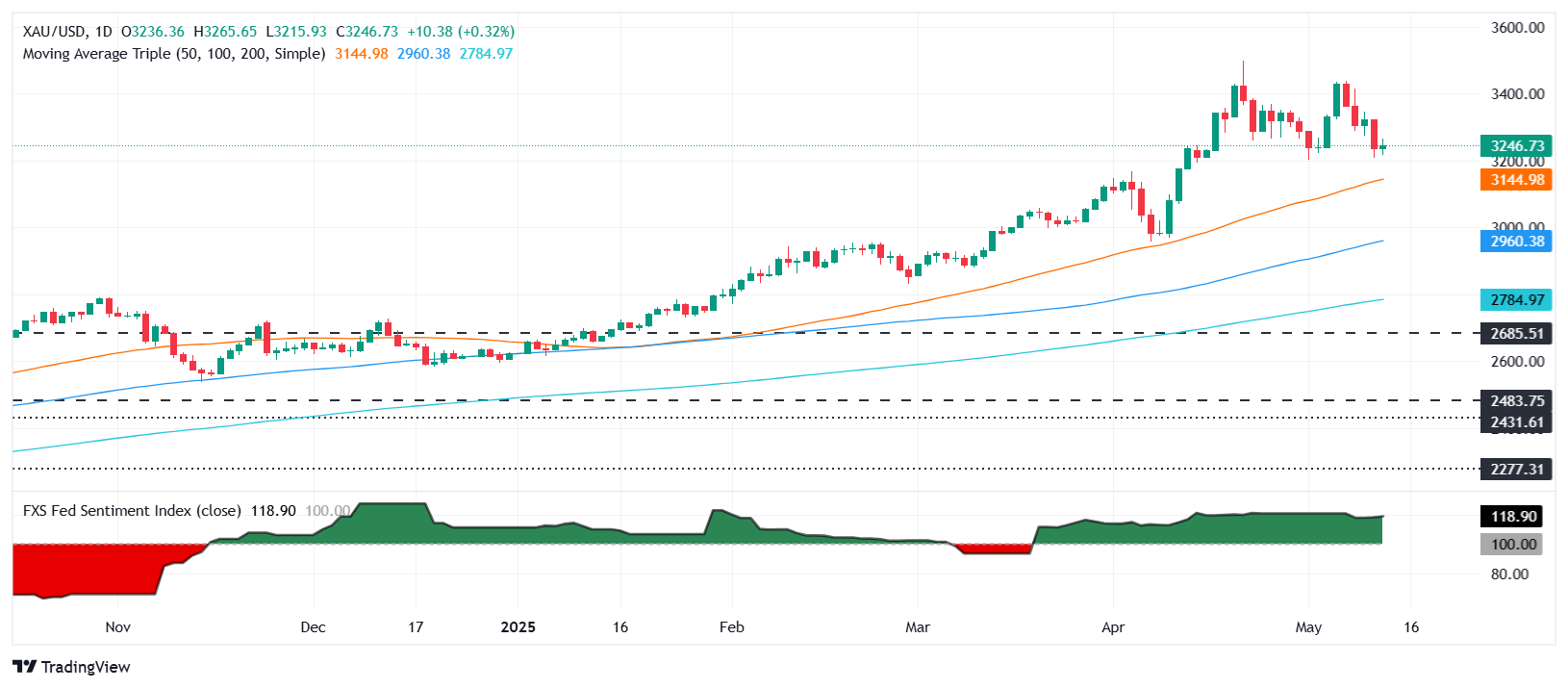Gold price rebounds on cool US CPI reading but remains trapped on risk-on mood
- XAU/USD climbs toward $3,250 as soft US inflation data boosts sentiment, but Fed stance caps gains.
- April CPI misses slightly, easing US Dollar pressure with limited immediate impact from tariffs.
- Analysts caution inflation may rise as tariffs gradually push up goods prices.
- Fed expected to cut rates twice in 2025; focus shifts to US PPI and Retail Sales for guidance.
Gold prices traded with a positive tone on Tuesday, following Monday’s drop of over 2.70%, exchanged hands at around $3,250, up by 0.42%. A softer-than-expected US inflation report and the trade truce between China and the US may keep Gold prices capped beneath the $3,300 figure.
US inflation data for April was slightly softer than expected by market participants on a monthly basis. Annual basis figures were aligned with projections, indicating that the tariff effect has not been reflected so far in the “hard data.”
Meanwhile, analysts at a major US commercial bank revealed that tariffs have boosted goods prices, “but larger increases are in the pipeline.”
Money market participants are still seeing a restrictive Federal Reserve (Fed). The December 2025 fed funds rate futures contract estimates the US central bank will ease 52 basis points of easing. This implies two rate cuts as Fed officials projected since last year’s December meeting, further confirmed by the latest Summary of Economic Projections in March.
Ahead this week, traders are eyeing the release of the Producer Price Index (PPI) and US Retail Sales data.
Daily digest market movers: Gold price edged up, still capped by high US Treasury yields
- US Treasury bond yields are climbing with the US 10-year Treasury note yield edging up 1.5 basis points to 4.489%. Meanwhile, US real yields are also steady at 2.199% as indicated by the US 10-year Treasury Inflation-Protected Securities yields.
- The US CPI in April expanded by 0.2% MoM, below forecasts of 0.3%, but up from March’s -0.1% number. Core CPI rose by 0.2% MoM, up from the previous month but beneath estimates of 0.3%.
- On an annual basis, the US CPI increased by 2.3% YoY, a tenth below estimates and the previous month's reading, and core metrics remained unchanged at 2.8% YoY.
- The announcement of a tariff agreement between the US and China improved risk appetite and sent Bullion prices plunging. Nevertheless, traders should be aware of recent developments regarding US trade policies and geopolitics as new catalysts could emerge and push Gold prices in either direction.
- The World Gold Council revealed that the People’s Bank of China added 2 tonnes to its Gold reserves in April – for the sixth consecutive month. The National Bank of Poland increased by 12 tonnes in April to 509 tonnes; while the Czech National Bank increased its reserves by 2.5 tonnes in April.
XAU/USD technical outlook: Gold price advances steadily with buyers eyeing $3,250
The Gold price rally has stalled, yet a “double-top” candle chart appears to be emerging, which could send XAU/USD prices toward the $3,000 figure and beyond. Momentum shows that buyers' strength is fading and that sellers are stepping in.
For a double-top confirmation, sellers must clear the May 1 low of $3,202. Once surpassed, the next stop would be $3,100, $3,000, and the minimum objective at $2,950.
Conversely, If XAU/USD edges back above $3,300, buyers will face the next resistance at $3,350. If surpassed, the next ceiling level would be $3,400 and beyond.

Gold FAQs
Gold has played a key role in human’s history as it has been widely used as a store of value and medium of exchange. Currently, apart from its shine and usage for jewelry, the precious metal is widely seen as a safe-haven asset, meaning that it is considered a good investment during turbulent times. Gold is also widely seen as a hedge against inflation and against depreciating currencies as it doesn’t rely on any specific issuer or government.
Central banks are the biggest Gold holders. In their aim to support their currencies in turbulent times, central banks tend to diversify their reserves and buy Gold to improve the perceived strength of the economy and the currency. High Gold reserves can be a source of trust for a country’s solvency. Central banks added 1,136 tonnes of Gold worth around $70 billion to their reserves in 2022, according to data from the World Gold Council. This is the highest yearly purchase since records began. Central banks from emerging economies such as China, India and Turkey are quickly increasing their Gold reserves.
Gold has an inverse correlation with the US Dollar and US Treasuries, which are both major reserve and safe-haven assets. When the Dollar depreciates, Gold tends to rise, enabling investors and central banks to diversify their assets in turbulent times. Gold is also inversely correlated with risk assets. A rally in the stock market tends to weaken Gold price, while sell-offs in riskier markets tend to favor the precious metal.
The price can move due to a wide range of factors. Geopolitical instability or fears of a deep recession can quickly make Gold price escalate due to its safe-haven status. As a yield-less asset, Gold tends to rise with lower interest rates, while higher cost of money usually weighs down on the yellow metal. Still, most moves depend on how the US Dollar (USD) behaves as the asset is priced in dollars (XAU/USD). A strong Dollar tends to keep the price of Gold controlled, whereas a weaker Dollar is likely to push Gold prices up.

